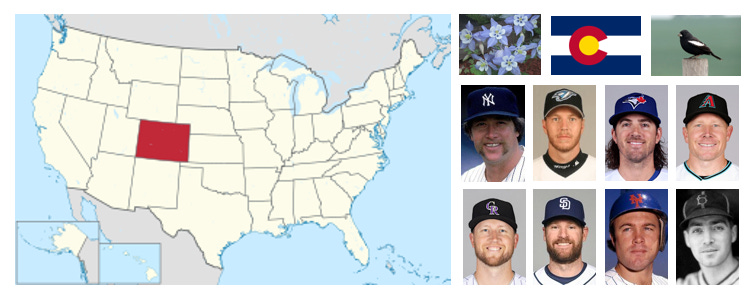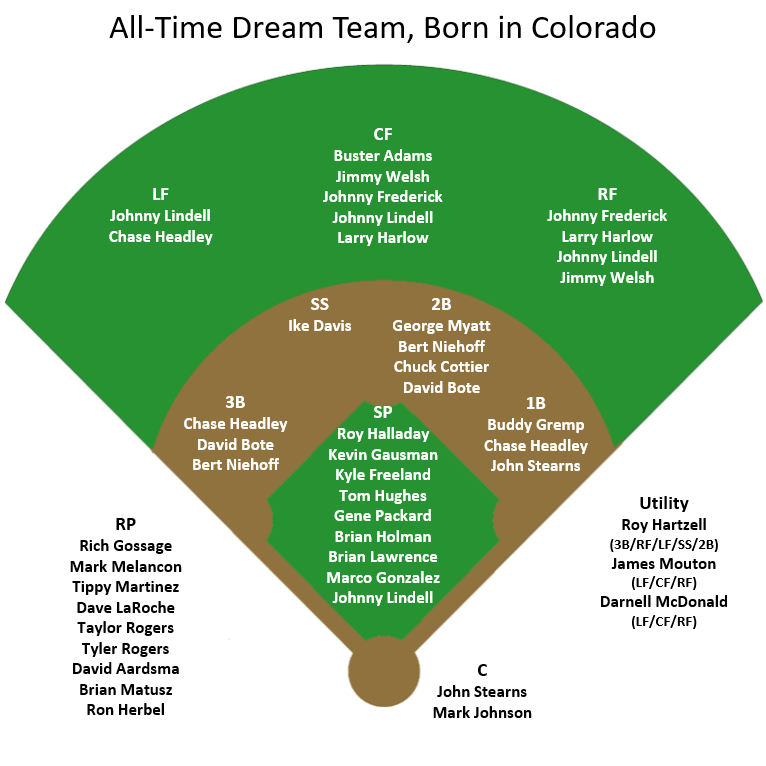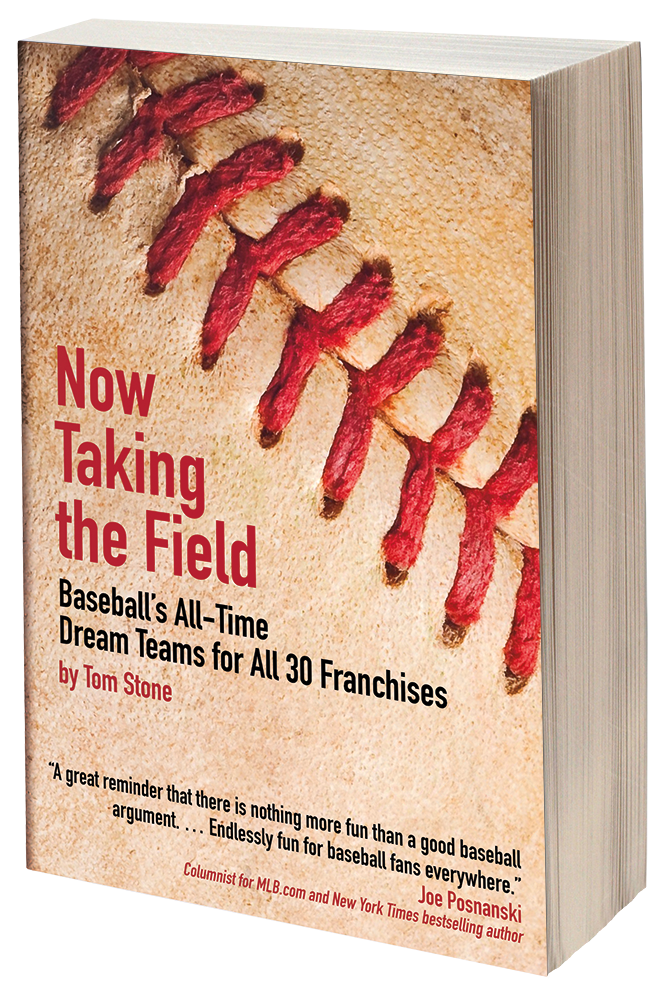Colorado's Baseball All-Time Dream Team
What would a dream team roster look like for major league players born in Colorado?
Issue #112
This is the 16th article in a series where I am creating all-time dream teams for players born in each of the fifty US states. I’m publishing each write-up on the anniversary date that the particular state joined the union. So far I’ve covered Maryland, Louisiana, Minnesota, South Carolina, Rhode Island, Wisconsin, Kentucky, Tennessee, Arkansas, West Virginia, New Hampshire, Virginia, Idaho, Wyoming, and New York.
Next up is a return to the mountain west with Colorado, which became the 38th state admitted to the union on August 1, 1876 (according to Wikipedia.) That year was of course the Centennial for the nation, leading Colorado to get the nickname “The Centennial State.”
Important caveat to what follows: I’m creating these all-time dream teams based on the birthplace data available at baseball-reference.com. I realize this might mean some players will appear for a state’s all-time dream that seems odd, e.g., a player who was born in one state but lived there only briefly, while then spending most of his youth, or especially critical years playing baseball in high school in another state. So that is an important caveat to the below dream team roster—and I’ll discuss the players that I know went to high school in a state other than Colorado towards the end of this article (and vice-versa, those born elsewhere but who went to high school in Colorado.)
Here is the all-time dream team I came up with for players born in Colorado:
Like some of the other states I’ve covered so far, this roster has some definite weak spots. Overall I’d say the pitching staff is much stronger than the position players, who are headlined by the likes of 3B/1B/LF Chase Headley and OF Johnny Fredericks. Headley played 12 years in the majors for the Padres and Yankees from 2007-2018, generally providing moderate power with a career .263/.342/.399 slash line and 106 OPS+. His best season came in 2012 when he uncharacteristically belted 31 HR to go with an NL-leading 115 RBI, 17 SB, a .286/.376/.498 slash line, 145 OPS+, and a Gold Glove Award.
Johnny Frederick came to the majors as a 27-year old rookie, setting a rookie record of 52 doubles to go with 127 runs, 206 hits, 24 HR, and a .328 average while playing for the Brooklyn Robins (Dodgers). His numbers generally declined in subsequent seasons, in part because leg injuries hampered his abilities. This also led to a shift from CF to RF and eventually to part-time duties with frequent use as a pinch hitter. After only six seasons in the majors, he ended up in the minors where he continued to hit well for another six seasons.
Another OF on this roster who isn’t a household name but had a few good seasons is Johnny Lindell. He played parts of 12 seasons in the majors from 1941-1954, mostly with the Yankees, and including 1943 and 1944 when he led the AL in triples. Buster Adams is also not generally well known, but played parts of six seasons from 1939-47, going back and forth between the Cardinals and Phillies a few times. His best seasons came in 1944 when he hit 35 doubles with 17 HR, and then 1945 when he hit 22 HR with 109 RBI.
Roy Hartzell was a utility man during the dead-ball era, playing from 1906-16 with the Browns and Yankees, stealing 20+ bases in six of those seasons. A more rare thief on the bases was John Stearns, a catcher with the Mets for ten years in the late 1970s and early 80s. A four-time All-Star, Stearns set the NL record for SB by a catcher with 25 in 1978.
Starting lineups for this all-time dream team could look like this:
Against RHP:
Johnny Frederick RF (L)
Roy Hartzell SS (L)
Johnny Lindell LF (R)
Chase Headley 1B (S)
Buster Adams CF (R)
John Stearns C (R)
Jimmy Welsh DH (L)
George Myatt 2B (L)
David Bote 3B (R)
Against LHP:
Johnny Frederick RF (L)
Buster Adams CF (R)
Johnny Lindell LF (R)
Chase Headley 3B (S)
John Stearns C (R)
Ike Davis SS (R)
Bert Niehoff 2B (R)
Buddy Gremp 1B (R)
James Mouton DH (R)
These lineups definitely have some soft spots, but there were a few spots where platoons would help. At 2B there is a natural platoon between George Myatt (1938-39, 43-47) who hit left-handed, and Bert Niehoff (1913-18) who hit right-handed. At DH I paired Jimmy Welsh (1925-30) and the light-hitting but speedy James Mouton (1994-2001).
The Ike Davis listed is not the recent slugging 1B for the Mets, but rather Isaac Marion Davis who had a brief career in the majors in 1919 and 1924-25. His 1925 campaign for the White Sox was solid with 105 runs, 31 doubles, 9 triples, and 19 SB, so I platooned him with the lefty-hitting Hartzell at SS.
The weakest spot here is arguably first base, where the only player born in Colorado that I could find who primarily played 1B was one Lewis Edward “Buddy” Gremp, who played from 1940-42 but after serving in the military returned to the minors only. With only 113 major league games to his name, I elected to shift Headley over to 1B against RHP and get David Bote into that lineup at 3B. Bote has played parts of five seasons with the Cubs and at age 30 is having a fine 2023 season for their AAA club.
Compared with the hitters, the talent level for pitchers is a bit higher for this dream team roster, starting with two Hall of Famers in SP Roy Halladay and RP Rich Gossage. After Halladay I went with current Blue Jays hurler Kevin Gausman and then current Rockies starter Kyle Freeland. How you rank the other starting pitchers I included could be debated, and I included Johnny Lindell at the end of the list as he actually both started and ended his professional baseball career as a pitcher. He was an outstanding pitcher for several years in the Yankees minor league system, but soon after coming to the majors manager Joe McCarthy switched him to the outfield. During spring training in 1949 he developed a knuckleball pitch, and that would be useful later as he would work as a knuckleball pitcher in the minors and then briefly for the Pirates and Phillies.
The intimidating Goose Gossage is of course the top reliever on this roster, but there was a surprising group of other solid candidates including Mark Melancon, Tippy Martinez, Dave LaRoche, David Aardsma, and the Rogers brothers, Taylor and Tyler.
To wrap up, several of the above players were born in Colorado but grew up and in particular went to high school in other states, including at least the following:
OF/SP Johnny Lindell - California
C Mark Johnson - Georgia
OF Larry Harlow - New Mexico
OF James Mouton - California
SP Brian Holman - Kansas
RP Dave LaRoche - California
SP Brian Lawrence - Texas
RP Brian Matusz - Arizona
What about the other direction—born elsewhere but went to high school in Colorado? I found several good players including most notably these five who would definitely have made it on the above all-time dream team if the criteria were altered:
SP Smokey Joe Wood, born in Missouri
RP Brad Lidge, born in California
RP Jay Howell, born in Florida
3B/1B Jeff King, born in Indiana
SP Danny Jackson, born in Texas
Smokey Joe Wood would slot in as co-ace with Roy Halladay, and Jeff King would be a welcome addition given how weak the 1B candidates were. Lidge and Howell would more than make up for the loss of LaRoche, further bolstering an already strong bullpen. And Jackson, a two-time All-Star and AL Cy Young runner-up in 1988, would round out an improved five-man rotation.
Others who were born elsewhere but went to high school in Colorado, include in no particular order:
SP Dennis Rasmussen, born in California
SP Stan Williams, born in New Jersey
SP Jim Rooker, born in Oregon
C Josh Bard, born in New York
SP Brandon McCarthy, born in California
3B Kevin Kouzmanoff, born in California
RP Jesse Crain, born in Toronto, Canada
1B Greg Bird, born in Tennessee
RP Doug Brocail, born in Pennsylvania
1B Bobby Dalbec, born in Washington
RP Will Ohman, born in Frankfurt, Germany
All data is from Baseball-Reference.com, and also their subscription service Stathead.com. If you are a big sports fan, be sure to check out the latest features at Stathead and the Sports Reference family of sites. The state map, flag, flower, and bird images are from Wikipedia.
Did you know? I wrote a book with the same title as this Substack newsletter / blog: Now Taking the Field: Baseball’s All-Time Dream Teams for All 30 Franchises. It was published in early 2019, by ACTA Sports, the publisher of the annual Bill James Handbook and other popular titles. You can learn more about it at www.NowTakingTheField.com, or buy directly at Amazon and other booksellers.






